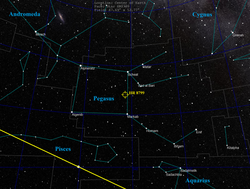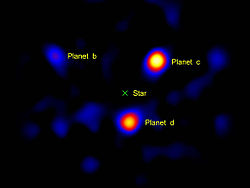HR 8799 Debris Disk
Astronomers think that the three large planets known to orbit the star are disturbing small comet-like bodies, causing them to collide and kick up dust. The extended dust halo has a diameter of about 2,000 astronomical units, or 2,000 times the distance between Earth and the sun. For reference, the size of Pluto's orbit is tiny by comparison, with a diameter of about 80 astronomical units.
This image was captured by Spitzer's multiband imaging photometer at an infrared wavelength of 70 microns in Jan. 2009.
Relevantní obrázky
Relevantní články
HR 8799HR 8799 je přibližně 30 milionů let stará hvězda hlavní posloupnosti v souhvězdí Pegase, vzdálená 129 světelných roků (39,6 parseků) od Země. Její hmotnost činí zhruba 1,5násobek Slunce a má 4,9krát vyšší zářivý výkon. Součástí soustavy jsou prstenec prašných částic a nejméně čtyři velké planety, které s Fomalhautem b představovaly vůbec první exoplanety, jejichž pohyb na oběžných drahách byl potvrzen technikou přímého zobrazení. .. pokračovat ve čtení



